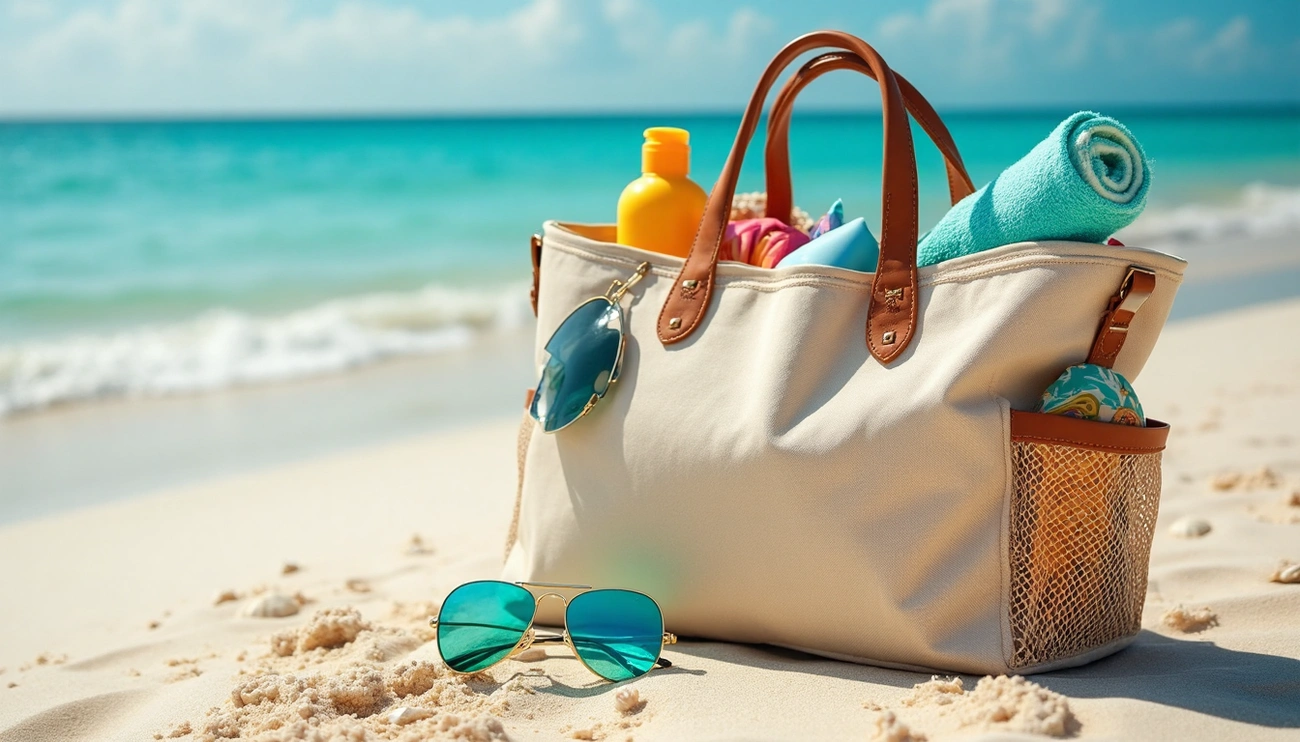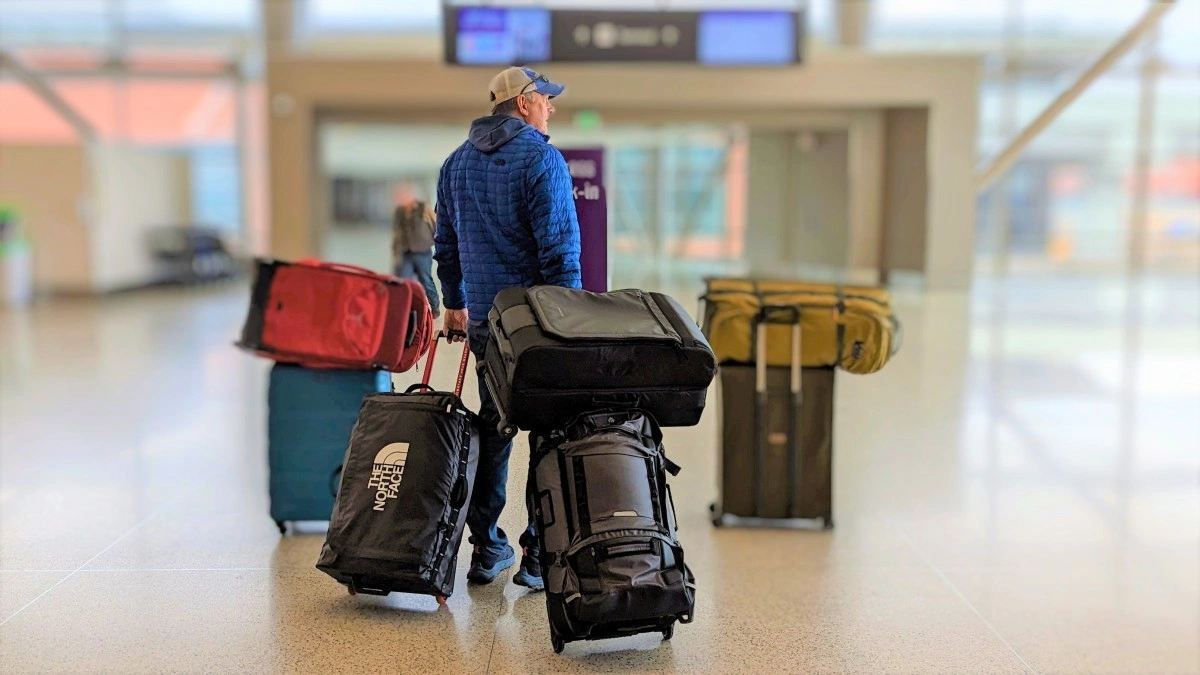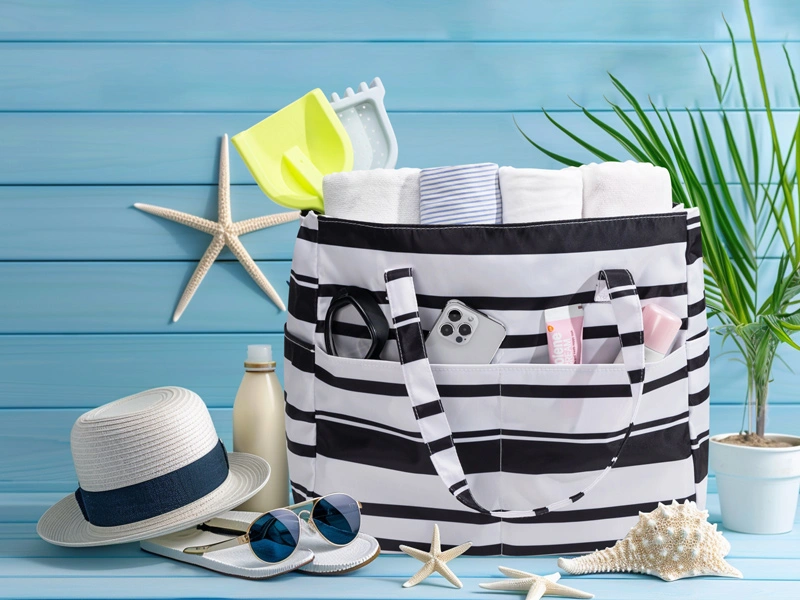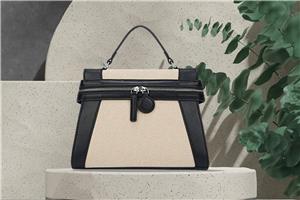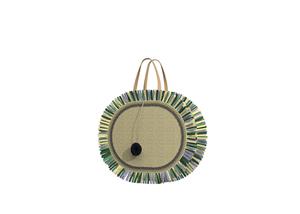How to Choose the Perfect Beach Bag: A Stress-Free Guide for Summer Travel
How to Choose the Perfect Beach Bag: A Stress-Free Guide for Summer Travel
Quality beach bags can carry up to 50 pounds of gear and keep your essentials protected from sand, water, and sun. Many beachgoers still struggle with flimsy totes that collapse on uneven sand. Their bags often lack enough space to hold family essentials.
A beach bag serves as more than just another accessory—it's vital for a successful beach day. You might need a waterproof bag to protect electronics, a spacious 35-liter carrier for family outings, or a stylish tote that stands upright on uneven terrain. Your choice makes all the difference. Your beach bag's primary role remains clear: it must carry and safeguard your personal items from the elements while maintaining its esthetic appeal.
This piece will help you think about everything you need before purchasing your next beach companion. We'll explore material choices, size requirements, smart features, and comfort options that matter most. You'll learn to select a beach bag that combines functionality, durability, and style perfectly to create stress-free summer adventures.
Understand What Makes a Good Beach Bag
Your beach bag's material choice goes beyond looks - it's about how well it works in tough beach conditions. The right material can make a huge difference in how long your bag lasts, how comfortable it feels, and how well it keeps your stuff safe from sand and water.
Why material matters: canvas, mesh, EVA, and more
Cotton canvas stands out as a favorite beach bag material because it feels soft on bare skin and lasts a long time. The material is light, dries fast, and you can toss it in the washing machine to get rid of sand and stains. Canvas bags usually come with extra-strong stitching that handles heavy loads - perfect for carrying towels, snacks, and beach gear for the whole family.
Mesh beach bags do a great job letting sand fall through instead of building up inside. These bags are light, dry quickly, and clean up easily since they're made mostly from nylon or polyester. But remember that those same holes that let sand out also let it in, which might not be ideal for your electronics or books.
EVA (ethylene-vinyl acetate) brings something new to beach bag materials. This flexible, tough polymer creates bags that bend better than rubber but still keep water out really well. You'll find many EVA bags have sturdy bottoms that stay upright on bumpy sand, which helps keep water and sand from getting inside.
Beach lovers who care about the environment now have better choices beyond the usual materials. Jute resists UV rays and breaks down naturally, while recycled fabrics like rPET (made from plastic bottles) stay tough but leave less of a mark on the environment.
Waterproof vs. water-resistant: what's the difference?
People often mix up "waterproof" and "water-resistant," but they mean two very different things:
Water-resistant materials hold off water for a while but eventually let moisture through. They work fine in light rain or with occasional splashes but can't handle being wet for too long.
Waterproof materials never let water get through, no matter how long they're exposed to it.
Hydrostatic head tests measure how waterproof something is by seeing how much water pressure it takes before water breaks through. A higher pressure rating (in millimeters or kilopascals) means better waterproofing.
Most "waterproof" beach bags are actually just really good at resisting water. Real waterproof bags need waterproof fabric plus waterproof zippers, buckles, and sealed seams. You might want to get special waterproof pouches inside your beach tote if you need to protect electronics or valuable items.
How sand-resistant fabrics can save your day
Finding sand all over your bag can ruin your post-beach mood. Sand-resistant beach bags use clever design features to cut down on this common problem.
Bags with mesh bottoms let sand fall right through instead of collecting at the bottom, which keeps your stuff cleaner throughout the day. Some bags made from coated polyester or PVC stop sand from sticking to them, so you can just shake them off before heading back to your car or hotel.
Modern beach bags often use "splash-proof" materials that repel water, sand, and sunscreen spills. These special fabrics wipe clean easily - which comes in handy with sticky sunscreen or dripping ice cream.
The difference between sand-resistant and sand-proof matters. No bag keeps all sand out, but a well-designed beach bag substantially cuts down on the sand that follows you home. Think about whether you want sand to fall through (mesh) or bounce off (nylon, polyester, EVA) based on what you usually bring to the beach.
Choose the Right Size and Shape for Your Trip
Image Source: Outdoor Gear Lab
The right beach bag size can make or break your day at the shore. Nobody wants to struggle with an overpacked tote or run out of space. You need the sweet spot that lets you carry everything without weighing you down.
Solo vs. family trip: how much space do you need?
The number of people sharing your beach bag will shape your size choice. Solo beachgoers can get by with a small beach bag about 15 inches wide by 12 inches tall. This gives you plenty of room for the basics—a towel, sunscreen, a book, and your stuff. These bags are light and easy to carry.
Couples or small groups do better with mid-sized bags, usually 16-20 inches wide and 13-15 inches tall. You can fit several towels, snacks, and all the basics without the bag becoming too heavy.
Families need something bigger. Large beach bags (21-24 inches wide by 15-18 inches tall) hold multiple towels, spare clothes, toys, and snacks for the whole crew. All-day outings might call for extra-large bags over 24 inches wide. Some big beach bags can handle up to 50 pounds of gear—perfect if you like to be ready for anything.
Think about these things when picking your size:
How long you'll stay at the beach
What you usually bring along
The walk from your car to the sand
Where you'll store the bag at home
Tote, backpack, or oversized: which one matches your style?
The bag's shape and how you carry it matter just as much as its size. Classic tote beach bags come with long handles and open tops. They're great for grabbing things quickly or stuffing in awkward items like beach toys. Many totes have extra-long handles so you can still sling them over your shoulder when they're full.
Backpack-style beach bags spread the weight across both shoulders. This helps a lot if you're hiking to a remote spot. They free up your hands—super helpful for adventure seekers or parents with kids in tow. Some clever designs let you switch between backpack and shoulder carry.
Big structured bags with strong bottoms stay upright on the sand. Parents love this feature. At about 45cm high with a 40cm rectangular base, these bags keep towels, toys, snacks, and water bottles organized. The solid build stops everything from spilling on bumpy ground.
When to go compact: foldable and packable options
Travelers need something different. A bulky beach bag eats up precious suitcase space. That's why many brands now make packable beach bags just for travelers.
Foldable beach totes scrunch down into tiny pouches. Some fold flat like origami, while others squeeze into built-in pouches. This lets you bring a beach bag without giving up space for other stuff.
On top of that, these bags work for more than just beach days. Use them as a shopping tote, everyday bag, or your personal item on planes. Ripstop nylon bags are tough despite being lightweight—some can hold up to 50 pounds when open.
Canvas totes with cushy handles give you structure but still fold almost flat. Lined raffia bags look beachy while keeping your things protected. These hybrid designs work great for both beach days and regular use.
Look for Smart Features That Add Convenience
Image Source: Amazon.com
A beach bag's convenience depends on smart organization that keeps your essentials available and safe. The most spacious bag can become frustrating without proper compartments that separate wet from dry items and valuables from sunscreen.
Pockets and compartments for better organization
Smart beach bags have multiple pockets that turn messy jumbles into organized systems. The external side pockets give quick access to water bottles. Mesh pockets let sand and moisture escape rather than collect at the bottom. Organizational experts say using clear pouches or dedicated compartments really improves your beach day experience.
"I always keep all my sunscreens in one bag. This has SPF for the body, face, and lips," notes one professional organizer. Families benefit from separate compartments for each person's belongings to avoid frantic searching through shared bags. Premium beach bags now come with dedicated spots for everything—sunglasses, keys, phones, and wet swimsuits too.
Zippers, closures, and waterproof pouches
Good security features protect your belongings from theft and weather. Top zipper closures stop items from falling out when your bag tips over on bumpy sand. Magnetic snaps let you access items quickly while keeping them safe from casual theft.
Waterproof pouches inside larger bags create safe zones for your stuff. Beach bags with "splash-proof" material shield your items from water, sand, and sunscreen spills. You can wipe these special sections clean without leaving stains. Waterproof zippered pockets work best to store electronics, car keys, and wallets.
Insulated sections for snacks and drinks
Built-in cooler compartments mean you won't need a separate cooler at the beach. These insulated areas keep drinks cold and snacks fresh throughout hot days. Some bags even come with detachable coolers you can use on their own.
The UYLIA Beach Cooler Bag represents this versatile approach with special spots for dry and wet items among its insulated cooler section. Other designs use leak-proof linings to stop condensation from getting to other items. This smart combination lets you pack everything from cold water bottles to fresh fruit without worrying about temperature or moisture problems.
Don’t Overlook Comfort and Carry Options
People often overlook comfort when they pick a beach bag, yet it can make or break your day at the beach. Even the most beautiful, right-sized beach bag becomes useless if it hurts your shoulder or feels uncomfortable to carry.
Strap types: shoulder, hand, or convertible
The way you carry your beach tote bag shapes your comfort and convenience. Shoulder straps spread weight over a wider area, which helps you manage heavy loads better during those long walks from the car to your beach spot. You'll want straps at least 1-1.5 inches wide to avoid that painful digging into your shoulders and reduce muscle strain.
Hand-carry options give you better control for short distances but aren't practical when you're lugging lots of stuff. Many high-end beach bags come with reinforced handles that have fabric or neoprene padding to protect your hands from getting cut by the material.
Convertible straps are maybe even the best solution, giving you several ways to carry your bag:
Regular shoulder carry for casual walking
Cross-body style when you need your hands free
Backpack mode to spread weight across both shoulders
Weight and padding: how it affects long walks
Your beach bag's empty weight sets the stage for how comfortable it'll be when loaded. Light materials like ripstop nylon or polyester keep the base weight down, so you can pack more stuff without making it too heavy. Padded straps are a vital feature - they help absorb pressure points that build up during those long walks on hot sand or boardwalks.
Why adjustable straps can make a difference
Adjustable straps work great for different body types and carrying styles. If you're tall, you can extend the straps to stop the bag from riding up under your arm. Shorter people can tighten them to keep the bag from hitting their legs while walking.
Beyond height, you can adapt the straps to match what you're carrying. Heavy loads work better with shorter straps that keep weight close to your body's center, while lighter loads feel fine with longer straps. This flexibility ended up changing how you carry your beach stuff - turning an awkward haul into an easy carry.
Style, Versatility, and Long-Term Care
A beach bag is more than just something to carry stuff—it shows your personal style and can lift your whole vacation experience. Taking good care of it will help it last through many summers.
Choosing a beach tote bag that matches your vibe
Your personal style plays a big role in picking the perfect beach companion. Simple designs with clean lines and bright colors create a laid-back feel for casual beachgoers. People with sporty or preppy priorities often love bold stripes. Those with sophisticated taste go for structured shapes or woven straw options. Some Milan-based companies make Mediterranean-inspired blue and yellow striped prints that bring coastal vibes instantly.
Adding a personal touch makes your beach bag special. You can customize it with names or initials on canvas totes or natural materials. Seagrass and woven straw give a unique rustic look. Your bag becomes unmistakably yours with these touches.
Using your beach bag beyond the beach
Great beach bags are useful way beyond the shoreline. A quality tote works great for grocery trips, farmers market hauls, or daily errands. Some bags double as gym bags with separate spots for workout gear.
Foldable beach bags are perfect travel buddies. To name just one example, see the Aloha tote that fits neatly in carry-on luggage but serves many purposes at your destination. Structured straw bags with classic shapes shine at resort outings or outdoor dining. Style and function go hand in hand.
How to clean and store your travel beach bag
Good maintenance starts with daily habits. Empty and shake your bag after each beach trip to get rid of sand and debris. Here's how to handle stains:
Canvas bags: Machine wash in cold water with mild detergent, turn inside out first
Straw bags: Spot clean only, avoid soaking
Mesh bags: Rinse under running water to remove sand
Let your bag air dry completely. High temperatures from dryers will damage fabric fibers. Baking soda inside the bag for several hours removes odors—just vacuum it out later. White vinegar in wash water works too.
Keep your beach bag in a cool, dry spot away from sunlight when not using it. A dust bag gives extra protection during off-season storage. You might want to spray canvas materials with waterproofing spray to make them last longer.
Conclusion
The right beach bag can make or break your summer adventures. A good mix of material, size, and features will revolutionize your beach trips. Canvas gives you durability and softness, while mesh lets sand filter through instead of piling up inside. On top of that, waterproof options will keep your electronics and valuables safe from unexpected splashes.
Your specific needs determine what size works best. Solo travelers can go with compact bags, while families need spacious totes to fit towels, toys, and snacks. Your carrying priorities play a big role too. Totes let you grab things quickly, and backpacks spread the weight across your shoulders for longer walks.
Smart organization is what separates messy digging from finding things easily. Multiple pockets, secure closures, and waterproof pouches keep your stuff safe and available all day long. Features like padded, adjustable straps help you stay comfortable during those long walks from your car to the perfect spot on the sand.
Your beach bag is also a style statement that matches your vacation look. You'll find options with bold patterns, classic stripes, or natural materials. These bags are a great way to get more use beyond beach trips - they work just as well for groceries, gym visits, or casual outings.
It's worth mentioning that regular cleaning and proper storage will keep your beach companion in great shape. This basic care will give a reliable travel partner for many summers ahead. With this detailed knowledge, you can pick a beach bag that combines practical use with personal style, and make every beach day relaxed and fun.
Key Takeaways
Selecting the right beach bag involves balancing material durability, size requirements, and smart features to ensure stress-free summer adventures.
• Choose materials wisely: Canvas offers durability and comfort, mesh allows sand to filter through, while EVA provides water resistance and structure.
• Size matters for your group: Solo travelers need 15x12 inch bags, couples require medium 16-20 inch options, families benefit from large 21-24 inch totes.
• Prioritize smart organization: Look for multiple compartments, waterproof pouches, and insulated sections to keep items separated and protected.
• Don't sacrifice comfort: Padded, adjustable straps and lightweight materials prevent discomfort during long walks to the beach.
• Invest in versatility: Quality beach bags serve multiple purposes beyond the shore—grocery shopping, gym visits, and travel companions.
The best beach bags combine practical functionality with personal style, transforming from simple carriers into essential summer accessories that enhance your entire vacation experience.
FAQs
Q1. What materials are best for a beach bag? The best materials for beach bags include cotton canvas for softness and durability, mesh for sand filtration, and EVA (ethylene-vinyl acetate) for water resistance and structure. Canvas is popular due to its comfort, lightweight nature, and easy maintenance, while mesh allows sand to escape easily. EVA offers excellent water resistance and helps the bag maintain its shape on uneven surfaces.
Q2. How do I choose the right size beach bag? Choose your beach bag size based on your needs. For solo travelers, a small bag (about 15x12 inches) is sufficient. Couples or small groups should opt for medium-sized bags (16-20 inches wide). Families benefit from large totes (21-24 inches wide) that can accommodate multiple towels, toys, and other essentials. Consider the duration of your beach visit and the items you typically carry when selecting the size.
Q3. What features should I look for in a beach bag? Look for beach bags with multiple compartments for organization, waterproof pouches to protect electronics and valuables, and insulated sections for keeping drinks and snacks cool. Secure closures like zippers or magnetic snaps are important for preventing items from spilling out. Additionally, consider bags with external pockets for easy access to frequently used items like water bottles or sunscreen.
Q4. How can I ensure my beach bag is comfortable to carry? For maximum comfort, choose a beach bag with padded, adjustable straps. Wide straps (at least 1-1.5 inches) help distribute weight and prevent digging into your shoulders. Convertible straps offering multiple carrying options (shoulder, cross-body, or backpack style) provide versatility. Also, consider the bag's empty weight – lighter materials like ripstop nylon or polyester allow you to carry more without discomfort.
Q5. How should I care for and clean my beach bag? To maintain your beach bag, empty and shake it after each use to remove sand and debris. For canvas bags, machine wash in cold water with mild detergent. Spot clean straw bags, and rinse mesh bags under running water. Always air dry your bag completely and avoid using a dryer. For odor elimination, sprinkle baking soda inside, let it sit for hours, then vacuum. Store your bag in a cool, dry place away from direct sunlight when not in use to prolong its lifespan.

